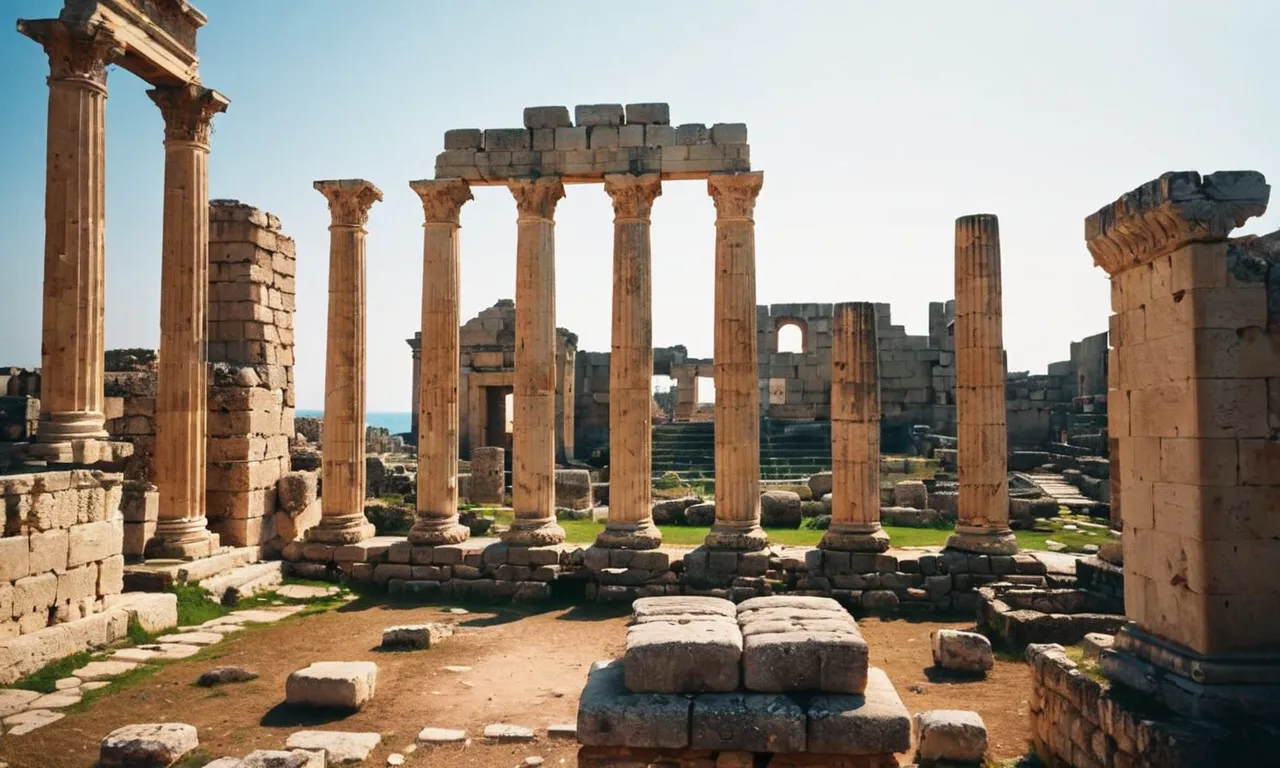Who Destroyed Tyre In The Bible?
The ancient Phoenician port city of Tyre has a long and storied history intertwined with biblical events. If you’re looking for a quick answer, the city of Tyre was destroyed by the Babylonian king Nebuchadnezzar in the sixth century BCE.
This article will examine the various biblical prophecies concerning Tyre’s destruction, the historical sackings of the city by the Babylonian and Macedonian empires, the city’s eventual decline, and the implications these events may have on biblical prophecy and archaeology.
Old Testament Prophecies Against Tyre
Ezekiel’s Prophecy
The prophet Ezekiel foretold the destruction of Tyre in the 6th century BC, predicting that King Nebuchadnezzar of Babylon would conquer the city (Ezekiel 26:7-14). Ezekiel said Tyre’s walls and towers would be destroyed and the debris thrown into the sea, making the land “as bare as the top of a rock” (Ezekiel 26:4).
This prophecy began to be fulfilled when Nebuchadnezzar besieged Tyre for 13 years.
Isaiah’s Prophecy
In the 8th century BC, the prophet Isaiah also foretold Tyre’s destruction. He said Tyre would be forgotten as a nation for 70 years, but then later restored as a trading center (Isaiah 23:15). Sure enough, Tyre regained its independence and wealth after Babylon fell to the Persians in 538 BC.
Joel and Amos’ Prophecies
The minor prophets Joel and Amos spoke against Tyre in the 8th century BC for enslaving and selling Jewish people. Joel 3:4-6 says Tyre would be judged and held accountable for stealing Israel’s wealth and selling its people.
Amazingly, Alexander the Great later punished Tyre in 332 BC for resisting his conquest.
Zechariah’s Prophecy
In 520 BC, the prophet Zechariah said many nations would join Tyre in worship of the true God someday (Zechariah 9:1-7). Today, Christianity has spread globally and many Tyre descendants could be believers. What an incredible fulfilled prophecy after 2,500 years!
Nebuchadnezzar’s Siege and Destruction of Tyre
The 13-Year Siege
In 587 BCE, the Babylonian king Nebuchadnezzar II laid siege to the island city of Tyre off the Mediterranean coast for 13 years after the Tyrians revolted against Babylonian rule. According to the ancient historian Josephus, Nebuchadnezzar was seeking revenge and hoped to capture Tyre’s rumored great wealth.
However, the heavily fortified island city was nearly impregnable.
Nebuchadnezzar ordered his army to build siege ramps from the mainland to the island, but the Tyrians counter-built defensive walls. Frustrated, the Babylonians eventually gave up on storming Tyre directly and hoped to starve them out instead.
The siege lasted 13 years but Tyre persevered thanks to supplies brought in by sea. Finally in 574 BCE, both sides agreed to a compromise treaty.
The Sack of Tyre
Though the long siege was unsuccessful militarily, economic analysis suggests Nebuchadnezzar de facto controlled Tyre for over a decade. Archaeological evidence shows that during those years, Tyre’s mainland suburbs were destroyed.
Over time, the Babylonians razed coastal settlements, pilfered economic resources, and sold many Tyrians into slavery.
So while Nebuchadnezzar did not conquer the island of Tyre outright, the prolonged siege allowed Babylon to sack and subjugate the mainland city, devastating Tyre’s economic power. Tyre would recover but they agreed to pay tribute to Babylon for years after.
Archaeological Evidence
Modern archaeological digs have found layers of ash and debris on the former mainland site of Tyre dated to Nebuchadnezzar’s siege in the early 6th century BCE. Ancient buildings, artifacts, and human remains paint a picture of the destruction and violence that took place.
For example, excavators discovered a mass grave containing over 1,500 skulls and bones, evidence of mass slaughter. They also found two scarab seals near the city entrance inscribed with names of Tyrian nobility, indicating attempts to flee the city.
Together, the ruins tell a sobering story of what was likely a brutal end to old Tyre.
Alexander the Great’s Conquest of Tyre
Alexander’s Siege
In 332 BC, Alexander the Great set his sights on the island city of Tyre off the Mediterranean coast as part of his campaign to conquer the Persian Empire. Known as the “rock on which sailors used to moor their boats”, Tyre was considered impregnable and one of the greatest fortified cities in the ancient world (Ezekiel 26:14, 17).
Alexander was determined to seize Tyre, both for its strategic value as a port city and to demonstrate his might. His engineers built acauseway almost 1 km long to bridge the channel between the mainland and the island, using rubble from old Tyre.
The Tyrians fiercely resisted the months-long siege, countering Alexander’s assaults from their walls and navy.
Frustrated by the city’s stubborn resilience, Alexander had the rubble from the destroyed buildings on old Tyre tossed into the sea to extend the mole. After 7 months, his forces finally breached into the city walls in early 332 BC.
Defeated, thousands of Tyrian civilians were killed or sold into slavery.
The Fall of Tyre
The capture of Tyre was a pivotal victory for Alexander, proving his ability as a military commander to take even the most impenetrable stronghold. With their navy crushed and city razed, the once-mighty Tyrian empire that dominated maritime trade and colonized Carthage and Cadiz was no more.
Alexander offered a sacrifice to the gods at the temple of Melqart, the Tyrian Heracles. Though sparing the temple, he punished the city by executing some 2,000 rebels and sold 30,000 women and children into slavery. Tyre would never recover its former glory after this devastation.
The city’s conquest fulfilled the prophecies of Ezekiel 26-28, written over 250 years prior. Ezekiel predicted Nebuchadnezzar would destroy mainland Tyre (which occurred in the 500s BC), after which Alexander would slay Tyre’s “daughters on the mainland” and “scrape her dust from her and make her like a bare rock” – leaving only a place for fishermen to spread their nets.
Tyre as a Peninsula
Where Tyre once stood as an island city, it became a peninsula after Alexander’s siege, no longer surrounded completely by the sea. The causeway built during the siege changed the area’s geography and hydrography permanently.
Over time, sedimentation and sand accumulation made Alexander’s causeway merge more solidly with the island. Today, the former island of Tyre is a sandy peninsula protruding less than 1 km into the Mediterranean Sea.
The prophecy that Tyre’s rocks and soil would be thrown into the water came true both during Alexander’s siege and by natural processes over centuries.
Alexander the Great succeeded where Nebuchadnezzar failed in demolishing the island fortress of Tyre. In conquering what was seen as unconquerable, Alexander established himself militarily and fulfilled the site’s prophetic destiny.
Yet the city continued to be occupied afterward, with the Tyre of today a shadow of its former grand self.
Tyre’s Decline and Biblical Significance
From Powerful Port to Quiet Fishing Town
In ancient times, Tyre was one of the most prosperous and powerful port cities in the Mediterranean region. According to historical records, Tyre had extensive trade networks and colonies that stretched across the ancient world.
However, over the centuries, Tyre went from being a bustling hub of commerce to a quiet fishing town.
Archaeological evidence indicates that by the start of the Common Era, Tyre’s power and influence had already started to decline. Once a formidable maritime power, Tyre gradually lost control over its vast mercantile empire.
While trade still flowed through the port, it was a shadow of its former self.
One major factor in Tyre’s demise was a series of sieges and conquests by foreign powers like the Assyrians, Babylonians, and Macedonians. Over time, these invasions took their toll. Alexander the Great was even said to have constructed a land bridge in order to breach Tyre’s defensive walls set up in the sea.
Today, Tyre is but a faint reflection of its former grand status. The ancient city lies in ruins, with only a small modern settlement built on top of part of the old ruins. Fishing, along with some tourism, forms the backbone of Tyre’s current economy.
Rather than the clamor of merchants and ships, the sound of the sea breeze now predominates in this once great port.
Fulfillment of Prophecy
For believers, Tyre’s reversal of fortune represents an important fulfillment of Biblical prophecy. The Book of Ezekiel in the Old Testament contains several passages where the prophet Ezekiel predicts Tyre’s downfall.
Ezekiel 26:3-6 states: “therefore thus says the Lord God: Behold, I am against you, O Tyre, and will bring up many nations against you, as the sea brings up its waves. They shall destroy the walls of Tyre and break down her towers, and I will scrape her soil from her and make her a bare rock. “
This and other prophecies seem to uncannily describe Tyre’s fate through the centuries. The accuracy of Ezekiel’s predictions have led to much analysis over the years. For those who believe the Bible is divinely inspired, it solidifies their faith.
Others view Tyre’s decline as inevitable given the turbulent history of the region. Nevertheless, the haunting ruins of Tyre continue to have deep spiritual significance.
Though merely a quiet town now, Tyre’s rich history and connection to prophecy still draw visitors eager to walk through archaeologically important sites mentioned in ancient, venerated texts.
Conclusion
The ancient city of Tyre has a long and complex history intertwined with biblical prophecy. It was an influential Phoenician port city before suffering destruction at the hands of the Babylonian and Macedonian empires.
These sackings fulfilled prophecies in Ezekiel, Isaiah, Joel, Amos, and Zechariah concerning the city’s downfall. Today, Tyre exists as a quiet suburban fishing town, a shadow of its former grand status in the ancient world.
The city’s demise carried great biblical significance as a fulfillment of prophecy and sign of God’s ultimate sovereignty over all nations.








